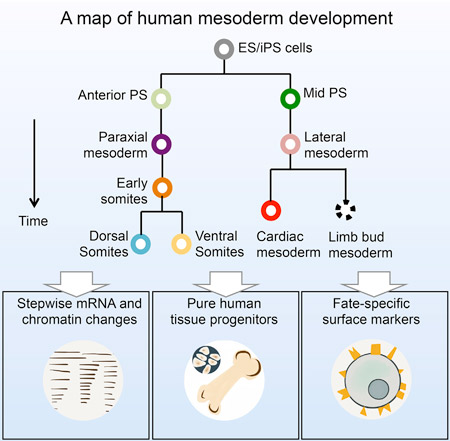Hertz Fellow Kyle Loh is Growing Human Tissue from Stem Cells for Regenerative Medicine
Imagine instead of waiting for months or even years on an organ donor list for a new kidney or heart, scientists are able to grow one for you, on demand, in a petri dish! The idea may not be as farfetched as it seems, as breakthroughs in stem cell research and regenerative medicine continue to bring science closer to that potentiality.
One rising star at the forefront of such research is Stanford School of Medicine graduate student Kyle Loh, a Hertz Fellow pursuing his PhD in developmental biology. Loh was the lead author of a groundbreaking research paper published in the journal Cell in July, “Mapping the Pairwise Choices Leading from Pluripotency to Human Bone, Heart, and Other Mesoderm Cell Types“. The study delineates a “roadmap” to growing 12 different human cell types (including bone, muscle and the heart) from embryonic stem cells over a period of days or weeks, instead of the usual timeframe of months or even longer.
“It’s not currently possible to turn stem cells into pure cells (very fast),” Loh said. “Now, we can quickly make bone cells into a bone for instance, so you can imagine the potential for creating new tissues. We’re still pretty early on, but so far there have been promising results.”
The study’s findings open the door to developing embryonic stem cells (derived from in-vitro fertilization) into many different kinds of cell types, which could help provide the necessary foundations for regenerative medicine. Healthy transplantable cells could be injected into the body to help ward off disease, or to correct autoimmune and degenerative disorders. Someday, scientists could even use stem cells to grow replacement organs such as kidneys or livers in a laboratory.
Although embryonic stem cells have shown promise, Loh said, their true value has yet to be realized, primarily due to the difficulties in precisely directing the stem cells to manufacture homogenous, pure populations of human tissues. Previously, many attempts have resulted in unwanted cell clusters that were impractical for molecular analysis or cell therapy. However, with this comprehensive project, Loh said he and his collaborators may be able to overcome those limitations.
“The trouble with stem cells is there are so many different destinations for thousands of different cell types,” Loh said. “We realize that in order to guide the cells, you need to know all the roads to their destinations. The potential has been there, but not much has been done with them before. This is uncharted territory.”
Growing up, Loh was a bit of a child prodigy. By the age of 12, he was already taking college classes. Two years later, he was researching stem cells at Harvard University, and at 16, he became one of the youngest graduates in the history of Rutgers University. After receiving his bachelor’s degree in Cell Biology and Neuroscience, Loh moved on to do his undergraduate research at the Genome Institute in Singapore and at Harvard University, where he joined the Harvard Stem Cell Institute.
Loh, who said he always had an interest in biology and stem cell research, was awarded a Hertz Fellowship in 2011, allowing him to meet many of the pioneers and luminaries in the field. Now 22, Loh is scheduled to finish his doctorate in September.
Loh said he hopes to remain in academia, but wherever he ends up, he wants to tackle his next challenge of injecting the progenitor cells into mice to see if there are any defects, and continue working on producing new human blood cells from stem cells.
